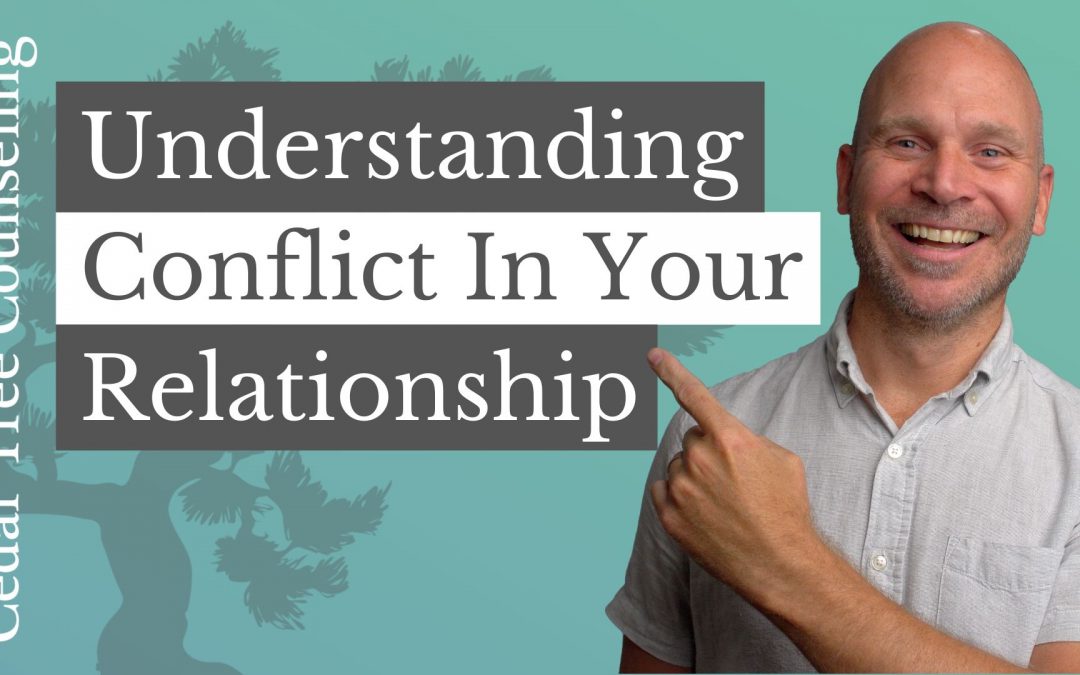I recently published a Vlog about how marriage therapy works, and since then I’ve had a lot of questions about one particular aspect of that talk.
There seems to be interest in learning a bit more about the conflict cycle or dance. So today I’m going to spend just a couple minutes giving a clearer explanation of what we call this all too common cycle.
Let’s begin with a really common cycle or dance that may feel somewhat familiar to you and your spouse. It goes like this:
1. The conflict cycle commonly will begin, right up here at the top, with an unmet need. So, person #1 has the need.
2. When that need is expressed, often in unhelpful, maybe even antagonistic ways, person #2 experiences an uncomfortable feeling; something along the lines of, “this expressed need is making me feel a negative emotion, perhaps inadequacy, accused, or like a failure.”
3. No one likes to feel those emotions, and to protect him or herself, person #2 erects a defense. This wall of defense says to person #1’s need, “I do not acknowledge this need.”
4. In response, person #1, having had his or her need diminished, seeks to defend the need. Here we have 2 people who have both erected walls of defense.
5. This is typically where conflict begins to accelerate, one or both running out from behind their wall hurling verbal attacks to break the other’s defenses and then retreating. Hyper-engagement or disengagement marks this part of the cycle.
6. When the fighting ends, often both person #1 and person #2 move into some form of isolation or feeling of loneliness. Some couples will do this for hours, others for days, and I’ve known some couples to stay in isolation for weeks at a time.
7. At any rate, for many couples this period of isolation, however long, will come to a close with some attempt at reconciliation, but often without a real sense of resolution.
8. Lastly, the couple will figure out how to move on or “let it go” for now.
9. This works until we come to the next unmet need.
Couples that find this conflict cycle all too familiar may have an unspoken rule in place: “I do not get to have the needs I have.” Does this sound at all familiar to you?
In my next vlog for couples I will lay out “The New Cycle” to give you some ideas about how to slowly change this dysfunctional dance, but for now, with your spouse, just try this. When conflict arises, try to name where you are in the cycle.
Are you finding it hard to hear your partner’s needs? Tell your spouse. Are you erecting a defense? Name it out loud. Are you beginning to attack or withdraw from one another? Say it. We can’t change the dance until we begin to see the moves that need changing.
——————————————————————–
Real change can happen, but typically not overnight. It takes time and effort to learn a new dance. In some ways it’s easier to just do what you’ve always done, but in time the old dance will lead you both to resentment and regret. Why not start now to own your conflict cycle?
If you feel you and your partner need help in identifying your conflict cycle, I would highly recommend finding a good couples therapist to help in the process. If we at Cedar Tree Counseling can be of service to you, please feel free to give us a call. We’re here to help.

Matthew Hanlon
Men & Couples Therapist | MA, LMFT
I help men and their families, who are hurting, angry, and struggling to find their way through life’s challenges, to create real and lasting change.
Choose A Topic!
Cedar Tree's Mission:
There are a lot of broken families who struggle to do life well together.
That’s why we help families create an environment where deeper connection & healing can happen.
GENEVA OFFICE
2172 Blackberry Drive, Suite 202
Geneva, IL 60134
(630) 797-9872
*By Appointment Only*
HINSDALE OFFICE
15 Spinning Wheel, Suite 125
Hinsdale, IL 60521
(630) 797-9872
*By Appointment Only*


